Mercantile Marine Buttons with “marketing” backmarks
According to Wikipedia: A merchant navy or merchant marine or mercantile marine is the fleet of merchant vessels (i.e. carrying passengers and/or cargo for hire) that are registered in a specific country. The title “Merchant Navy” was bestowed on British shipping fleets in honour of their service during WW1, with similar terms adopted by other nations.
Union Steamship Company
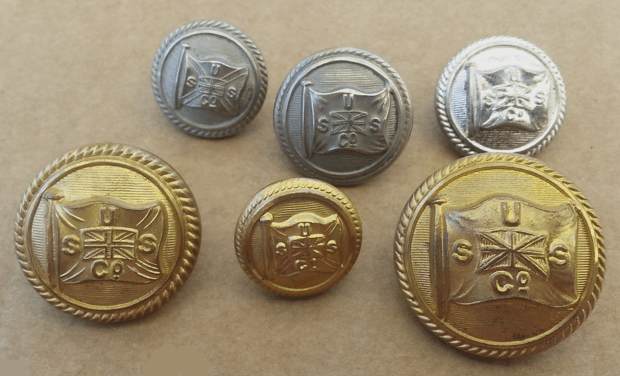
Three sizes of uniform buttons. Gilt is for officers, white metal for ratings. The rope design of rim has been traditional for naval uniforms from 1774.
Backs of the above:
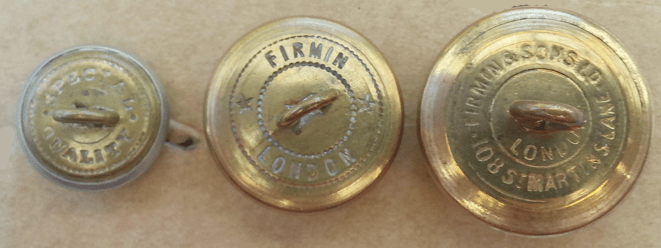
‘Special Quality’/ Firmin London/ Firmin & Sons ltd 108 St. Martins Lane London. Note the backs of the Firmin buttons have a “spun back” that have been burnished smooth, so that the crimped edge of the front shell is indistinguishable with the back plate.
Adelaide Steamship Company
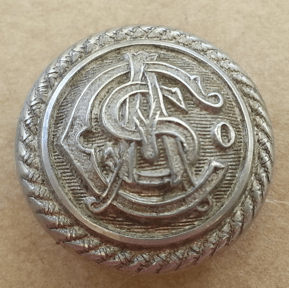
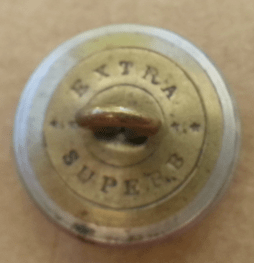
‘Extra Superb’
Backmarks such as ‘extra superb’ and ‘special quality’ were marketing terms used by button manufacturers to assure the customer of the quality of their product. The terms “double gilt’ and ‘treble gilt’ were originally to specify that the buttons had been coated twice or thrice with the British Government mandated levels of gold content in the gilt coating. There was a period when quality/materials/methods of production were compromised to save money, and buttons soon lost their gilding and looked shabby. Other marketing terms included ‘extra rich’, ‘best orange gilt’, ‘superfine’, extra fine’, ‘rich orange’, ‘treble standard’, ‘extra treble standard’, ‘rich colour’, and so on!
The Penny Magazine supplement on Birmingham, dated 1844 gives this information:
“A large part of the ingenuity of Birmingham has been displayed in finding means to give a golden surface at a small price. No other artisans can make a given weight of gold go so far in gilding trinkets as those of Birmingham; and it thus arises that cheapness of price has nowhere else reached to such an extraordinary extent. “All is not gold that glitters,” may be said of gilt jewellery generally; but it must in fairness be said, that the surface of these articles is really gold, for however thin the film may be, yet in the cheapest work it is continuous and unbroken, differing from the coating given to better work only in the degree of thinness—except indeed that some of the gold may be more or less “fine” than others. The substance of which the trinket is made may be copper or brass, or one of the numerous modern varieties of “white metal” but all alike are susceptible of receiving a superficial coating of gold. The method of gilding is generally analogous to that which we shall presently speak of in respect of buttons; but the electro-process, described in our last Supplement, is becoming extensively applied to this purpose.”
“The gilding is a more elaborate process. The gilt buttons are, in the odd but concise language of the workmen, called “all-overs” or “tops,” according as they are gilt all over, or only on the outer, exposed surface. There is also a distinction between the “yellow” and the “orange” gilding, the former being affected in colour by the previous use of a mixture called “similor” (“gold-resembling,” as it seems to signify), made of zinc and mercury. We will therefore select an “orange all-over” and an “orange top” as examples of the processes adopted.”
New Zealand Shipping button
http://www.austbuttonhistory.com/new-zealand-button-history/#New_Zealand_Shipping_Co
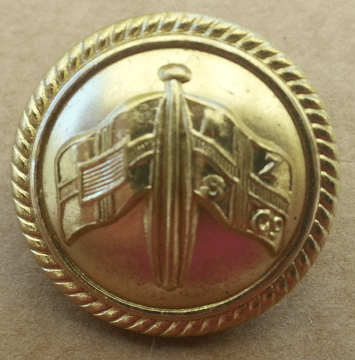
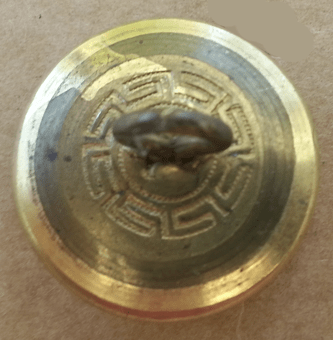
This button has a ‘meander pattern’ or ‘Greek key’ as a backmark. Whilst there was a manufacturer John Spencer 1799-1837 who used this pattern on the back of his buttons, that would be too early for this shipping company. It is another marketing-type backmark, possibly to suggest ‘classical quality’?
For any comments or questions, please use the Contact page.
